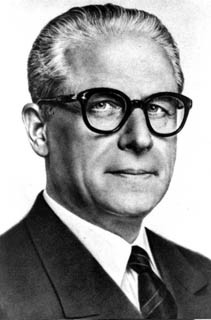Giovanni Gronchi
|
Senator for life Giovanni Gronchi OMCA |
|
|---|---|

Giovanno Gronchi official photo (aged 68), 1955.
|
|
| 3rd President of Italy | |
|
In office 11 May 1955 – 11 May 1962 |
|
| Prime Minister |
Mario Scelba Antonio Segni Adone Zoli Amintore Fanfani Antonio Segni Fernando Tambroni |
| Preceded by | Luigi Einaudi |
| Succeeded by | Antonio Segni |
| President of the Chamber of Deputies | |
|
In office 8 May 1948 – 29 April 1955 |
|
| Preceded by | Umberto Terracini |
| Succeeded by | Giovanni Leone |
| Minister of Industry and Trade | |
|
In office 18 June 1944 – 1 July 1946 |
|
| Prime Minister |
Ivanoe Bonomi Ferruccio Parri Alcide de Gasperi |
| Preceded by | Attilio Di Napoli |
| Succeeded by | Rodolfo Morandi |
| Personal details | |
| Born |
10 September 1887 Pontedera, Italy |
| Died | 17 October 1978 (aged 91) Rome, Italy |
| Nationality | Italian |
| Political party |
Italian People's Party (1919–1926) Christian Democracy (1943–1978) |
| Spouse(s) | Carla Bissatini (m. 1944–78); his death |
| Alma mater | Scuola Normale Superiore di Pisa |
| Profession | Teacher |
| Religion | Roman Catholicism |
Giovanni Gronchi, OMCA (Italian pronunciation: [ʤoˈvanni ˈɡroŋki]; 10 September 1887 – 17 October 1978) was a Christian Democratic Italian politician who became the third President of the Italian Republic in 1955, after Luigi Einaudi. His presidency lasted until 1962 and was marked by a controversial and failed attempt to bring about an “opening to the left” in Italian politics. He was reputed the real holder of the executive power in Italy from 1955 to 1962, backward the various Prime Ministers of this time.
He was born at Pontedera, Tuscany, and was an early member of the Christian Movement founded by the Catholic priest don Romolo Murri in 1902. He obtained his first degree in literature and philosophy at the Scuola Normale Superiore di Pisa. Between 1911 and 1915 he then worked as a high-school teacher of classics in several Italian towns (Parma, Massa di Carrara, Bergamo and Monza).
He volunteered for military service in the First World War and when it was over he became in 1919 one of the founding members of the Catholic Italian Popular Party. He was elected to represent Pisa in both the parliamentary elections of 1919 and 1921. A trade-union leader in the Italian Confederation of Christian Workers, in 1922–1923 he served in the first government of Benito Mussolini as Under-secretary for Industry and Commerce. In April 1923, however, a national meeting of the Popular Party held in Turin decided to withdraw all PPI representatives from the government. He then went back to his role in the leadership of the Catholic trade unions, and tried to face the daily violence brought against them by the fascist squads.
...
Wikipedia
